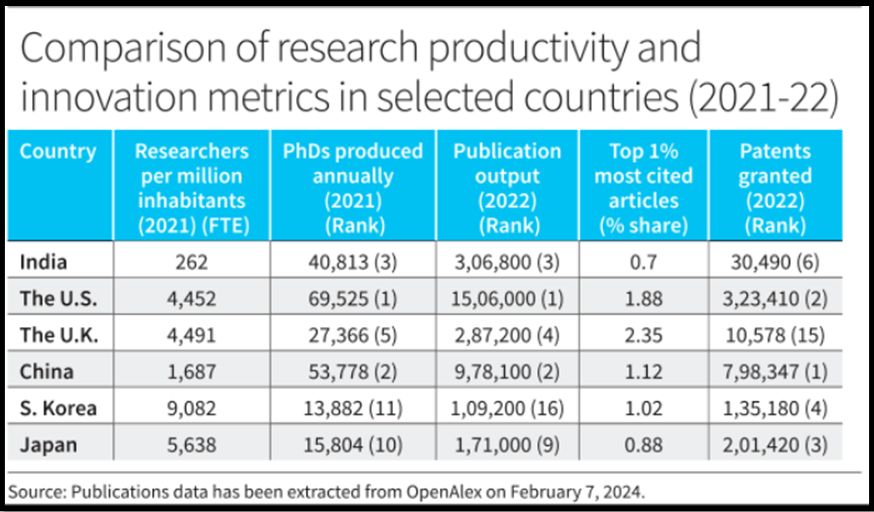INDIA’S R&D FUNDING, BREAKING DOWN THE NUMBERS
Syllabus:
GS 3:
- Awareness in the fields of IT, Space, Computers, robotics, nano-technology, bio-technology and issues relating to intellectual property rights.
Focus:
- India’s technological and manufacturing aspirations hinge on a transformative shift in its R&D landscape
Source:- The Hindu
Breaking down India’s R&D Funding:
- Interim Budget Announcement:
-
- The announcement in the interim Budget for 2024-25 includes a corpus of ₹1 lakh crore to bolster the research and innovation ecosystem in India.
- Rebranding of the slogan ‘Jai Jawan Jai Kisan’ to ‘Jai Jawan, Jai Kisan, Jai Vigyan, Jai Anusandhan’ signifies the emphasis on research and innovation for development.
- R&D Expenditure and GDP Share:
- India’s Gross Expenditure on Research and Development (GERD) increased from ₹6,01,968 million in 2010-11 to ₹12,73,810 million in 2020-21.
- However, research and development investment as a percentage of GDP is 0.64%, trailing behind major economies like China, Germany, South Korea, and the United States.
- Research Output and Innovation:
- India annually produces 40,813 PhDs, ranking third globally after the United States and China.
- India ranks third globally in research publications, with over 3,00,000 publications in 2022.
- India secured the sixth position globally in patent grants with 30,490 patents granted in 2022.
- Sector-wise Contribution to GERD:
- Government sector contributes 54% ($9.4 billion) of India’s total R&D investment.
- Key scientific agencies like the Defence Research and Development Organisation, Department of Space, Indian Council of Agricultural Research, and Department of Atomic Energy receive significant funding.
- Private sector contribution stands at approximately $6.2 billion, representing 37% of GERD.
- Higher Education Institutions (HEIs) contribute 8.8% ($1.5 billion) to R&D investment.
Status of India’s R&D:
Research:
|
Challenges in Sustainable Funding for R&D:
- Under-utilisation of Budgets:
-
- Departments like DBT, DST, and DSIR consistently under-utilise their budget allocations.
- In 2022-2023, DBT used only 72%, DST used only 61%, and DSIR spent 69% of their allocations.
- Delays in Disbursements:
- Lack of capacity leads to delays in grant and salary disbursements, impacting research and development projects.
- Uncertain Government Budget Allocation:
- Government funding for science is uncertain, subject to changes in political priorities and economic conditions.
- R&D funding is often insufficient compared to other sectors due to non-prioritisation within government budgets.
- Insufficient Private Sector Investment:
- In 2020-2021, the private sector contributed 36.4% of GERD, significantly lower than in developed countries.
- Factors like poor capacity for R&D evaluation and regulatory ambiguity deter private sector investment.
How can India Improve Its R&D Spending?
- Consistent Investment:
-
- Science requires consistent, large-scale investment. India needs to spend more on R&D to reach developed nation status.
- Philanthropic Funding:
- Encouraging wealthy individuals, corporations, and foundations to invest in R&D through philanthropy can boost funding.
- Establishing dedicated funds or grants for scientific research can attract donations.
- Industry-Academic Collaboration:
- Facilitating partnerships between academia and industry can leverage resources and expertise.
- Government incentives or tax breaks can incentivise such collaborations.
- Venture Capital and Angel Investors:
- Encouraging venture capital firms and angel investors to invest in R&D projects can provide significant funding.
- Startups and small enterprises often drive innovation and can benefit from private investment.
Government Initiatives related to R&D:
|
Source:
https://epaper.thehindu.com/reader
Mains Practice Question:
“Discuss the challenges and opportunities associated with India’s research and development (R&D) funding landscape, considering its comparative position globally and the role of government and private sectors. Assess the impact of recent policy initiatives on incentivizing R&D investment and fostering innovation for economic growth.”




